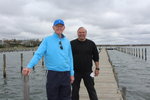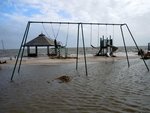

It has been a decade since the worst storm in recent memory hit Long Island. Superstorm Sandy, bringing high winds and harrowing storm surge, knocked out power and tested our collective resiliency.
Superstorm Sandy slammed the South Shore on Monday, Oct. 29, when a 10-foot-plus surge forced its way through. Local residents documented in this publication at that time described the devastation left behind by the storm as a “warzone.”
In Mastic Beach, although no one was injured throughout the course of the night, at least 100 people were documented as suffering from hypothermia and needing rescue. In Patchogue Village, about a dozen people were rescued from homes and at least 50 firefighters were out or on standby for 26 hours. Also, according to the Patchogue Ambulance Company, they went on about 32 calls that night. Dozens of streets were blocked due to downed trees, and by the end of the week about 35 percent of homes were still without power. In Bellport Village, both the golf course and bulkhead were breached, and the marina was fully underwater. The South Country Ambulance responded to over 117 emergency calls. The Town of Brookhaven estimated at that time that over 800 trees were downed throughout the entire town.
Below are some highlights of the work done by local governments:
PATCHOGUE VILLAGE
Just three years after the storm in 2015, funds were awarded for $1,235,184 for repairs at Mascot Dock. Also, the Patchogue Village board approved waiving building permit fees to homeowners still awaiting Superstorm Sandy funds from New York Rising, as well as contracting a blight study in the village.
In 2015, the Village of Patchogue applied for three grants to begin construction of the living shoreline/coastal resilience project at Shorefront Park, which was supposed to include a 1,200-foot timber boardwalk from South Ocean to Rider avenues with access to the beach.
The following year in 2016, Patchogue Village was awarded the grants for the Shorefront Shoreline project. A grant of $200,000 was awarded by the DOS for design of the shoreline.
Also, the village requested state funding from former Sen. Tom Croci in the amount of $600,000 for the Patchogue River east jetty rebuild and $50,000 towards the lighthouse. The Town of Brookhaven contributed $300,000 in support of the project and the Village of Patchogue also committed a total of $100,000 toward the total cost of just over $1 million. The reason for the rebuild and request for funding came due to massive deterioration and sinking with a poor jetty base, making navigation often complicated during high storm tides. Also, that year, repair work on Mascot Dock started with pavement and curbing replacement.
By 2017, grants of $2.3 million were awarded including $2.189 from the DOS; $324,000 from NYS Parks; and $45,000 from the NYS DEC for habitat restoration.
In 2018, the village and county officials, along with engineers, detailed plans to install sewers in the southern portion of Patchogue. The plan was an effort to improve environmental impacts, efficiency of waste management, and use of grant dollars. Also, over $2 million in a New York Department of State Division of Coastal Resources grant was awarded. The Village of Patchogue moved forward with plans for a living shoreline and boardwalk at Shorefront Park.
The new jetty was installed with flashing lights and a mini lighthouse. The east jetty provided protection for the river, ensuring the mouth doesn’t fill with sand, creating an impassable route. Since 2006, major storms, including Sandy, have contributed to the filling of the mouth and have broken down the jetty, deeming it ineffective.
In 2020, the Greater Patchogue COAD, Community Organizations Active in Disaster, organization officially activated for the first real crisis (pandemic) since forming in response to Superstorm Sandy. In addition to the seriousness and impact of the spread of the coronavirus, the organization provides relief to the countless in need.
“The Village of Patchogue, yes, we took a hit like most communities did,” acknowledged mayor Paul Pontieri, who was in office during the storm, while also stating he is proud of the way the village was able to bounce back. “The damage done in the village was manageable for us, despite the southern end of Patchogue being under nearly 3 feet of water.”
The village was able to use their emergency reserve funding to support all the work that needed to be done without borrowing money and impacting the taxpayer.
“We rebuilt Mascot Dock with the hope that it will withstand the same type of storm in the future,” he added, noting that they intend to do the same for Shorefront Park.
Additionally, he noted that the village was able to obtain multiple Sandy-impacted properties, which were then converted into parks for preservation. This includes the new 9/11 Memorial Park and several properties on Smith Street.
BELLPORT VILLAGE
In 2017, after years of deterioration and community advocacy, the Superstorm Sandy-destroyed jetty located in Beaver Dam Creek in Brookhaven Hamlet was rebuilt. The jetty, located at the end of Bellhaven Road in Bellport, was rebuilt to protect the channel from the littoral drift of sand, allowing boats to navigate safely through the waterway.
In 2018, the Bellport Village Board and the Waterfront Commission unveiled plans to replace the bulkhead at Bellport Marina. The project was made possible due to a funding request through the Federal Emergency Management Agency (FEMA).
That year, the National Park Service monitored the breach that formed on Fire Island after Sandy. The Fire Island Wilderness Breach Management Plan allowed for the continued use of scientific studies and area research to closely track the opening’s impact.
The Village of Bellport was also reimbursed by the Federal Emergency Management Agency for the construction of the Ho-Hum Beach pavilion that was destroyed in 2012. FEMA also obligated the village $2.6 million to repair the main pier, damaged as a result of Sandy.
In 2021, the pavilion at Ho-Hum Beach was slated to be removed and the bulkhead at the end of Browns Lane was to be replaced. It took the village 18 months to be reimbursed $630,000 pavilion, which gets besieged during high tide.
The village also completed the $2.6 million FEMA Superstorm Sandy restoration in July 2020.The major project included restoration of open areas and sinkholes in the main pier and the discovery of marine borers that literally created holes in the wood. It took several grant attempts with FEMA to obligate funds for the 2012 damage, which included the hiring of a diver to investigate the cause of the damage.
“Superstorm Sandy did some major damage to the village in the area of the marina with our bulkheads, and it was a major process to determine the damage and come up with the right solutions for our village,” said mayor Ray Fell. “We are very appreciative to FEMA for the help we received as far as funding these projects, and at this point, as we look back, it was a lot of work, but definitely worth the effort put in by the village trustees and our village clerk.”
At this point, he said all the work has been completed and the village is just awaiting some funding reimbursements.
BROOKHAVEN TOWN
Right after the storm in the 2012/2013 year, the town board determined that the effects of Superstorm Sandy to residents and properties within the Town of Brookhaven was devastating. The damage to improvements on property was significant and they wanted to provide real property tax assessment relief, in accordance with the Superstorm Sandy Assessment Relief Act, to the victims of the storm for the 2012-13 tax year to ease the tax burden upon residents suffering from losses to their real property. They then provided assessment relief for real property damaged by at least 10 percent of improved value.
In 2016, Brookhaven supervisor Ed Romaine and officials took a boat trip to the Bellport inlet and discussed the town’s position to keep the breach open. The inlet was left open under federal law to “let nature take its course.”
According to Romaine—who was elected to the seat in a special election that same year just 10 days after the storm—the hardest-hit area, Mastic Beach, was not yet part of the town, which was still operating as a village. In an effort to help revitalize the area after the storm, the town has acquired over 275 parcels covering 51-plus acres of land at a cost of $1.6 million on the South Shore alone. Also, as part of this process, 58 damaged houses were removed.
“We believe that if we have sufficient marshlands, it would absorb some of the shock from nor’easters and hurricanes,” Romaine said of the reason behind purchasing the properties. He also noted working with the county and federal government to help see sewering in Mastic.
“The hope is to see the federal government continue to invest to expand those lines south to Mastic Beach,” he added.
Comments
No comments on this item Please log in to comment by clicking here